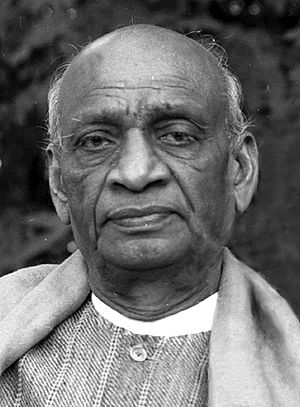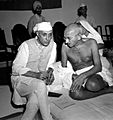Sardar Vallabhbhai Patel facts for kids
Quick facts for kids
Vallabhai Patel
|
|
|---|---|
 |
|
| 1st Deputy Prime Minister of India | |
| In office 15 August 1947 – 15 December 1950 |
|
| Monarch | George VI |
| President | Rajendra Prasad |
| Governor General | Louis Mountbatten C. Rajagopalachari |
| Preceded by | Position established |
| Minister of Home Affairs | |
| In office 15 August 1947 – 15 December 1950 |
|
| Prime Minister | Jawaharlal Nehru |
| Preceded by | Position established |
| Succeeded by | C. Rajagopalachari |
| 1st Commander-in-chief of the Indian Armed Forces | |
| In office 15 August 1947 – 15 December 1950 |
|
| Monarch | George VI |
| President | Rajendra Prasad |
| Governor General | Louis Mountbatten C. Rajagopalachari |
| Prime Minister | Jawaharlal Nehru |
| Preceded by | Position established |
| Succeeded by | Position abolished (merged to the President of India) |
| Personal details | |
| Born |
Vallabhai Jhaverbhai Patel
31 October 1875 Nadiad, Bombay Presidency, British India |
| Died | 15 December 1950 (aged 75) Bombay, Bombay State, India |
| Cause of death | Heart attack |
| Political party | Indian National Congress |
| Spouse | Jhaverben Patel (1880 - 11 January 1909) |
| Children | Maniben Patel Dahyabhai Patel |
| Parents |
|
| Alma mater | Middle Temple |
| Profession | |
| Awards | |
Sardar Vallabhbhai Patel (born October 31, 1875 – died December 15, 1950) was a very important leader in India's fight for freedom. He was a lawyer and a strong politician. After India became independent, he helped unite over 500 small kingdoms into one country.
Patel was greatly inspired by Mahatma Gandhi. He worked very closely with Gandhi. Even though many people wanted him to be the first Prime Minister of independent India, he stepped aside for Jawaharlal Nehru at Gandhi's request. He became India's first Home Minister. His hard work to unite the country earned him the name 'Iron Man of India'.
Contents
Early Life and Education
Vallabhbhai Patel was born on October 31, 1875. His birthplace was Nadiad village in what is now Gujarat. His parents were Zaverbai and Ladbai. Vallabhbhai's father had served in the army of the Queen of Jhansi. His mother was a very spiritual woman.
Patel first went to a Gujarati school. Later, he switched to an English school. In 1897, he finished high school. He then began to study for his law exams. He traveled to England in 1910 to get a law degree. He finished his law studies in 1913 from Inns of Court. After that, he returned to India and started his law practice in Godhra, Gujarat.
The British government offered him many good jobs because he was a skilled lawyer. However, he turned them all down. He strongly opposed the British government and its laws. He decided not to work for them.
Family Life
In 1891, Vallabhbhai married Zaverbai. They had two children together. Their daughter was Maniben Patel (1903-1990). Their son was Dahyabhai Patel (1905-1973). Sardar Patel's daughter became an activist. His son became a member of the Indian Parliament.
Patel later moved his law practice to Ahmedabad. He joined the Gujarat Club there. One day, he heard Mahatma Gandhi give a speech. Gandhi's words deeply moved Vallabhbhai. Soon, he started following Gandhi's ideas. He became a strong supporter of the famous leader. This meeting changed his life and led him to a successful career in changing India.
Role in India's Freedom Fight
In 1917, Sardar Vallabhbhai Patel became the Secretary of the Gujarat Sabha. This was the Gujarat branch of the Indian National Congress. In 1918, he led a big "No Tax Campaign" in Kaira. Farmers were told not to pay taxes after floods, but the British still demanded them. This peaceful protest made the British give back the land they had taken from the farmers. His efforts to unite the farmers earned him the title 'Sardar', which means 'chief' or 'leader'.
He strongly supported the Non-Cooperation Movement started by Gandhi. Patel traveled across India with Gandhi. He helped recruit 300,000 members for the movement. He also helped collect over 1.5 million rupees.
In 1928, farmers in Bardoli faced a new problem. The government raised their taxes. When the farmers refused to pay, the government took their lands. The protest lasted for more than six months. After many talks led by Patel, a deal was made. The lands were returned to the farmers.
In 1930, Sardar Vallabhbhai Patel was arrested. He had joined the famous Salt Satyagraha movement started by Mahatma Gandhi. His powerful speeches during the "Salt Movement" inspired many people. They then played a big part in making the movement a success. When Gandhi was in prison, Patel led the Satyagraha movement across Gujarat. He did this at the request of other Congress members.
Sardar Patel was released from prison in 1931. This happened after an agreement between Mahatma Gandhi and Lord Irwin, who was the Viceroy of India. This agreement was known as the Gandhi-Irwin Pact. In the same year, Patel was chosen as the President of the Indian National Congress. This was at their meeting in Karachi. There, the party discussed its future plans. The Congress promised to protect basic human rights. It was at this meeting that the idea of a secular nation was first thought of.
During the elections of 1934, Sardar Vallabhbhai Patel campaigned for the Indian National Congress. He did not run for election himself. However, he helped his party members win.
In the 1942 Quit India Movement, Patel continued to support Gandhi strongly. This was even when some other leaders disagreed with Gandhi's decision. He kept traveling across the country. He gave many heartfelt speeches to spread the movement's message. He was arrested again in 1942. He was held in Ahmednagar fort until 1945 with other Congress leaders.
Sardar Patel and India's Partition
Before India became independent, there were tensions between different religious groups. This led to violent events across the country. Sardar Patel believed that these conflicts could make India's new government weak. He thought this would be very bad for building a democratic nation.
In December 1946, Patel worked with V.P. Menon, a government official. They came up with a plan for separate areas based on religious groups. Patel represented India in the Partition Council.
Contributions to Independent India
After India gained independence, Patel became the first Home Minister. He was also the first Deputy Prime Minister. Patel played a very important role in uniting India. He successfully brought together about 565 small kingdoms under the Indian government. The British had given these rulers a choice. They could join India or Pakistan, or stay independent. This made the task very difficult.
The Congress party gave this huge job to Sardar Patel. He started working to unite them on August 6, 1947. He succeeded in bringing almost all of them together. Only Jammu and Kashmir, Junagadh, and Hyderabad remained. He used his smart political skills to handle these situations. He made sure they joined India. The India we see today is largely thanks to Sardar Vallabhbhai Patel's efforts.
Patel was a key member of the group that wrote India's Constitution. He suggested that Dr. B.R. Ambedkar be appointed to this group. He was also very important in setting up the Indian Administrative Service and the Indian Police Service. He personally helped start the rebuilding of the Somnath Temple in Gujarat.
In September 1947, Patel dealt firmly with Pakistan's attempts to enter Kashmir. He quickly expanded the army and improved other important facilities. He often disagreed with Nehru's policies, especially about how to handle issues with Pakistan regarding refugees. He set up many refugee camps in Punjab, Delhi, and later in West Bengal.
Gandhi's Influence
Gandhi had a deep impact on Patel's political ideas. Patel promised to support Gandhi completely. He stood by Gandhi's principles throughout his life. Some leaders, like Jawaharlal Nehru, disagreed with Gandhi's idea that civil disobedience would make the British leave. But Patel always supported Gandhi.
Even when some Congress leaders were unsure, Mahatma Gandhi and Sardar Vallabhbhai Patel strongly pushed for the Civil Disobedience Movement. They made sure it started without delay. Patel gave up his chance to be Prime Minister of India because Gandhi asked him to. After Gandhi's death, Patel suffered a major heart attack. He recovered, but he believed it was because he was grieving silently for his mentor.
Death
Sardar Vallabhbhai Patel's health began to get worse in 1950. He knew he did not have much time left. On November 2, 1950, his health worsened even more, and he had to stay in bed. He died on December 15, 1950, after having a heart attack.
Honours After Death
- 1991 - He received the Bharat Ratna. This is India's highest award for civilians. It was given to him after his death.
- 2014 - His birthday, October 31, was declared Rashtriya Ekta Divas. This means National Unity Day.
- 2018 - The Statue of Unity was unveiled. This huge statue is dedicated to Patel. It is the world's tallest statue.
Images for kids
-
Painting of Sardar Vallabhbhai Patel as deputy prime minister that appeared in the 1948 issue of Chandamama magazine.
-
Maulana Azad, Jamnalal Bajaj, Patel (third from left, in the foreground), Subhash Chandra Bose and other Congressmen at Wardha.
-
Mahatma Gandhi sitting with Jawaharlal Nehru in 1942; Nehru would later serve as the first Prime Minister of India
See also
 In Spanish: Sardar Vallabhbhai Patel para niños
In Spanish: Sardar Vallabhbhai Patel para niños








